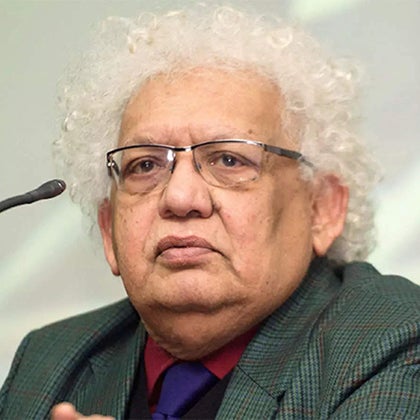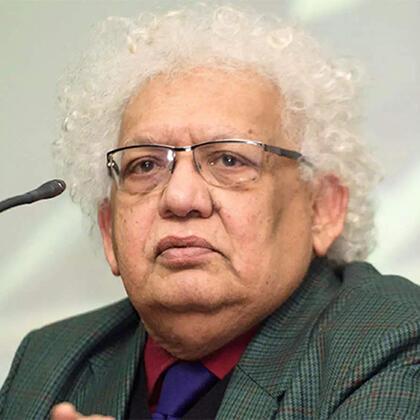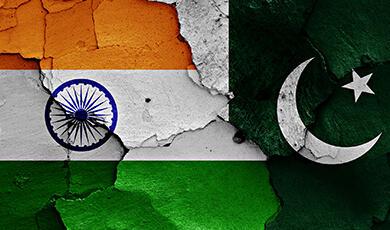Is India’s Development Sustainable?
Share
- Details
- Transcript
- Audio
- Downloads
- Extra Reading
Professor the Lord Desai, The London School of Economics and Political Science
Download Transcript
IS INDIA'S DEVELOPMENT SUSTAINABLE?
Professor the Lord Desai
I am going to presume that some of you know a lot about India and some of you know very little about India, so the first few minutes will be very introductory, and then I will get into more complicated things.
India, as you know, is the second most populous country, with a population of more than a billion. It is second only to China but, in terms of size, China is about six to seven times larger than India. China and India were both bywords in the 17th Century for prosperity and good governance. Voltaire used to write satirically about why the Bourbon kings were no good and that they should follow the example of the Chinese Emperor, and quite a lot of the English tried to study the Sanskrit classics in the late 18th Century.
Then suddenly things changed, and in the 19th and 20th Century China and India became bywords for poverty, misery, superstition and all sorts of bad things. As recently as the 1960s, when China had a famine and India had two bad harvests, Henry Kissinger said that 'When China and India can feed themselves, the world will have no more problems.' From there, we are now in a situation where our image of China and India are no longer negative but positive and, in some cases, not just positive but quite fearsome.
Now, India is in 2007 celebrating its 60th year of independence. In 1947 it became independent when it had a dominion status, and in 1950 it became an independent republic but still remained part of the Commonwealth. Over those years, India has always had an active government programme of economic development but, both in terms of the way the world thought about economic development and the way the Indians thought, the policies adopted in those years were not as growth-enhancing as one would have liked.
Then in 1991 India changed its direction of economic policy and adopted what is called liberal economic reform, and for the last 16 years it has stayed that course. Roughly speaking, India's income over the last 60 years has gone up about 10 times in inflation-adjusted terms, and undergone a population increase about three-fold, from roughly 350 million to a billion plus. Its per capita income grew also three-fold. This is not bad, compared to the previous 100 years of Indian economic history, but it is not as good as other countries in Asia: Japan, Korea, China, Singapore and so on.
One of the most interesting debates still going on in India, because it is a vibrant democracy, is how to evaluate the earlier period of 40 years, of what is called slow growth and also called the Hindu rate of growth, which is a little private joke among economists. The growth rate between 1947, roughly, and 1980, about 30 years, was 3.5% per annum total income and per capita income grew by about 1% per annum. A very simple calculation is this: whatever the growth rate is, divide 72 by that growth rate and you will see how many years it takes to double income. So if the growth rate is 2%, it takes 36 years to double per capita income. Therefore at a growth rate of 1.25% per capita income, it would have taken about 48 years to double. In 1980, the growth rate went up a little bit to 5.5% per capita income, and now the growth rate of per capita income is 7% per annum, so one expects per capita income to double in a decade.
How has India done this? The first phase is what I would call a nationalist phase, because of the experience of imperialism. India was subjugated to the British rule, and although industrialisation had happened during British rule, the perception was that if India was going to be truly independent it had to be totally self-reliant, and being totally self-reliant meant not much reliance on trade and only importing those things which were strictly necessary to make India in the future independent of imports. For example, it was felt that while India had industries, it did not have industries which could make the machines, because to make machines you need a steel industry and you need a machine tool industry and all those sort of basic industries. So much of the early development plan in India was designed to build the industrial capacity that India would need to become an independent, self-reliant, modern industrial nation. In a sense, this was also the model that the Soviet Union had used, but the Soviet Union had used it because it was it was isolated and subject to boycotts and sanctions in the 1920s and 1930s. India was, for all the time it has been independent, an open economy; it had maintained relations with all other countries, but somehow it chose not to rely on trade.
The consequence of this was that the modern industries which were created did not generate much employment, and the employment they generated was for highly skilled and highly educated people: engineers, scientists, people like that. Quite a lot of the mass of the population, both urban and rural, ended up in what I call informal sectors - so small scale employers, not very good conditions of work, precarious employment - or they stayed on the farm, in the rural areas. India's slow growth also meant that there was quite a large overhang of unemployment or under-employment in rural areas. There was a distinct and successful attempt to raise the productivity in agriculture, what is called the Green Revolution, which started in the 1960s. The Green Revolution was designed not to mechanise farming but to change the chemical/biological basis - improved seeds, fertilisers, water, and so on - and it was remarkably successful, so India became independent of any need to import any food grains very much by the mid-1960s.
This pattern continued till about 1980. There were the oil price rises in '73 and '79, and the 1970s were very troubled, with a lot of dissatisfaction. There was an emergency imposed by Mrs Gandhi, and so on. I think that there was a change of direction in 1980. First of all, the idea was that, yes, it would be self-reliant, but not so much; self-reliant in technology, but not in terms of finance. India began to borrow abroad, especially from Indians who had settled overseas. They started borrowing, growth rate went up, but it still was not good enough. It is one of those things in economics, that if you try to do everything yourself rather than rely on other people, rather than have division of labour, you do much worse than if you rely on division of labour.
You, as a person, could be a very good cook and a fantastic professor compared to another person, who could be both inferior to you either as a professor or as a cook, but it would still pay you to hire the other person as a cook if, as it were, your ratio of being professor and being a cook is higher than their ratio of being a professor and being a cook. It still pays you to do professorship full-time and let the other person do cook - although you could do both better. It is called division of labour.
The idea would have been that India should not worry about not making machines itself; it should just import machines and do whatever else it can do with the machines. Why are we hung up on making our own machines? What happened in the 1980s and 1990s was that in a sense this notion was vindicated when India became a byword for successful firms in the information technology industry. The way it happened obviously was that you clearly had imported computers - all the computers were imported - but the skill lay in the software: the skill in software, the ability to deliver complex software systems, which required abstract thinking, mathematical thinking and, for various reasons, which go quite far back into Indian history, Indians are very good at abstract thinking. So the IT industry was the first glimpse that a better strategy for India would be to borrow the machinery, buy the machinery abroad, whatever it needed, but then make a better product, and then that would be the right way for India to go.
What precipitated the change in India was that, by about 1991, India had borrowed monies abroad but basically not improved its economy sufficiently to be able to generate the export earnings to be able to repay the money borrowed from abroad. Before India became unsustainable, India had to borrow money abroad. When that happened, India ran into a very serious foreign exchange crisis, partly because many Indians were working in the Gulf countries, and repatriating money, and when the Iraq/Kuwait war happened, all those remittances stopped, oil prices went up, and India was caught in a crunch. At that stage, the people who had to lend money to India, the International Monetary Fund and so on, said, 'Look, enough is enough. You have had 50 years of mismanagement - do something about it!' Ethere were enough people in India who also realised that the world had changed, the world itself out there, even developed countries which used to have a mixed economy model, had gone more and more to a private sector market-led economy. The Soviet Union, which was an exemplar of an alternative policy, had more or less disintegrated as an economy, and therefore perhaps India should learn some lessons.
There began a liberal reform whereby previously all private industry was subjected to many rules - whether they could expand outward or not, how they could expand, they had to have permits and licences, and there were high tariffs, things like that. Slowly, India began to relax those rules. Because India is a democracy, any reform process is highly debated. There are vested interests created by the old order and there are people who will benefit from the new order, there are arguments, there are fears that if you abandon the tried and tested road, a lot of uncertainty will happen, a lot of risk, the poor will suffer and so on. All those fears were expressed, but luckily there was sufficient consensus in the country among all political parties that reform had to proceed, although slowly, but it had to proceed, and by 1990, we already had what is called globalisation. What globalisation did was that for many developing countries, which until the 1980s had to rely on foreign aid to be able to borrow capital, there were private firms and banks willing to invest in all these countries. Asian economies especially benefited enormously from the inflow of capital from abroad. Many Asian economies were able to combine their own skilled cheap labour and some unskilled labour with foreign capital and show spectacular growth.
By the 1980s, there were what is called the Asian Tigers - Hong Kong, Singapore, Korea, and Taiwan - which had shown spectacular growth, following the example of Japan, and later on there was Malaysia, the Philippines, Thailand and Indonesia, and then of course China emerged as a major fast-growing country in the 1980s and 1990s. China's transformation, despite being a community party ruled country, to a much more capitalist role to economic development, albeit under state control, startled the world very much. China achieved double digit growth rates, 10% growth rates, and has done so for the last 30 years, and this is really unprecedented in economic history, that a country can achieve growth rates like that. If you think about 10% growth rate, income doubles every seven years. Over 30 years you double, quadruple, eight-fold and sixteen-fold, so Chinese total income has gone up sixteen-fold since 1980. India has been able to grow its income, but only about three to four times in the last 20 years.
How did this happen? The state, or the government, had been doing a lot of detailed micro-management of which industry to expand, how much to expand, which technology to use and so on, and especially they had a very conservative view that they should allow an industry to double its output. Industry said, 'But I can sell four times as much!' and they said, 'No, you are not allowed to do that. We will tell you how much you can sell and you cannot decide.' All this micro-management is very good in a war economy; this kind of micro-management by the government is only way countries can fight wars, and this sort of model of government became popular in the First World War, when the Germans fought the First World War very much by organising the whole economy into single a command control thing, and then the Russians picked up that model and so on.
Once there is proliferation of products, proliferation of consumer income, people want to have choice. In a command control economy, you may make only white shirts, but people may want blue shirts as well as white shirts, or half-sleeves and full-sleeves and so on. This kind of choice is much better left to the producer himself.
In India's history, until independence in 1947, India had had some element of modern industrial development with Indian businessmen entrepreneurs. The Tata steel mill had been started in 1907, against the scepticism of many British steelmakers, but Tata was able make steel and the first steel output was being delivered by 1911, and Tata Steel has just celebrated its centenary. But there had always been substantial entrepreneurship before independence, when India had railways, cotton textile works, and so on. This front of private enterprise, entrepreneurship, was subdued in the 40 years after independence because the government said, 'No, no, we will tell you what to do - you don't know.' They of course were very happy, they were being told what to do, they had got to get to their licences, permits and make the profit, and they did not have to work very hard.
But that potential to be able to compete was suddenly released after 1991. Nobody would have expected, even 15 years ago when India changed its course, what would happened. Because at that time there were a lot of fears - what would happen if India abandoned the old principles and was left with this market-oriented development? Today, for example, India is the second largest investor in the UK. It exceeds Japan. America is the only other country which is larger than India investing here. The whole notion that a country which was historically thought to be poor, needing capital from abroad, needing foreign aid, all that, suddenly is emerging as an exporter of capital. When Tara Steel took over Corus (which used to be British Steel) everybody welcomed it; Corus were very thrilled that they were bought over by Tata.
The story now in both British and American economies is that if you want your firm to be restructured, if you want your company to become more profitable, you get Indian management. They really know how to manage quality while keeping costs low, and that is because they had to learn that in the 1990s and again later on, when suddenly India was open to foreign competition. Foreign firms, as I was saying, were making machines. India was making machines, but there were better machines being made abroad which were cheaper. When that happens, you have to suddenly start examining your own costs - 'Now, how am I going to...?'
India had a very interesting, very small, scooter making company, and that scooter making company was very much against any opening to foreign competition, and the businessman in charge was vociferous against all this market-oriented development. Now, within 15 years, he is very successful, is innovating. There are two other firms that are the foreign firms, and the whole Indian scooter market is completely transformed.
Before it happened, it was easily possible to imagine that the result would be exactly the opposite of that: it would be ruination of Indian industry, wipe out Indian industry, only foreign industry would come and operate, and that would be terrible. Given India's memories of colonialism, especially because English colonialism was led by a corporational firm, the East India Company, there is always a primordial fear of foreign companies coming and taking the country over once again. Instead of that happening, you suddenly have ability of Indian businessmen, and Indian workers and Indian technicians, to be able to withstand competition. I think what has happened, what happened in the information technology industry, was very much the kind of pattern that where Indian businesses score is in better design, better quality control, better product maintenance, and India is better at the software aspects, as it were, of running a business rather than the hardware aspects.
Another example - it might seem trivial but it is another very successful Indian industry - is the Indian film industry. India has the world's largest film industry, and India has had one of the world's largest film industries ever since cinema started. Very few people know that. What they call Bollywood was there before Hollywood started. Now, again, what is cinema? You imported the camera equipment and sound equipment, but the songs and the story and the ballad and the music, all the software aspects, is what makes cinema. Indian cinema, although it was in the Hindi language, was able to be shown in Latin America and Africa and the Middle East and so on, ages ago. It has now come to the Western shores because there is a large diaspora, but you will hear endless accounts of people in Africa saying, 'Oh, we go and see those films.' They do not understand the language, but in a sense, within India, there are a lot of people who go and see those films and they do not understand the language either, because not everybody speaks Hindi! So the film maker always makes films in which understanding the language is not essential to enjoying the film. It is like an opera. You have to make very broad brush films, where villains are baddies and you know they are villains, and goodies are goodies and you know they are goodies, and there are no shades of grey, and always entertainment and there are nine songs that are dancing songs and a big costume song. That kind of formula works across world markets, because it captures something which is universal. Of course Hollywood is much bigger in terms of world market share of the world cinema going public, but Indian cinema has the advantage of a very large home market - three billion people every year go to see them; there are three billion film tickets sold every year, and with a base like that you can really make films that you can go and export.
But although that kind of industry was possible, people did not really consider cinema to be a serious industry. The Indian Government did not even recognise it as an industry and it could not borrow money from banks until very recently. But now of course everybody sings its praise, because India has seen that the whole way of thinking about the economy is not about machinery and about cement and concrete and steel, it is about 'value-added' - can you make products which people would prefer to somebody else's products. They will buy and then you can make enough profit to make some more. You have to go on being better, go on improving your product design and so on, and all that requires enormous talent. Luckily for India - not just luckily, but partly because of the long tradition of doing business - there is a whole new generation of industrialists and managers. There is a lot of them with MBAs, either from abroad or from very good management schools in India, who are able to withstand competition from abroad and establish industries which are actually world beaters.
China was able to go precisely and continuously from one kind of growth model to another - I mean, the Chinese decide to go for that model, they just go, there is no messing around. They just make the switch and then there are no doubts. One of the interesting stories about India's growth is that in India's case there are always doubts. India is a reluctant globaliser, because of the democratic tensions and so on.
One very interesting thing that happened is that in Indian political thinking and Indian economic thinking, throughout the independence movement and later on, there was always the idea that economy had to produce results which were equitable. The idea of equity was very strong, and the idea was that India should not only have profitable industry but it should always look after equity. Therefore reduction of poverty was a very big issue. Quite remarkably, however, there was very little reduction in poverty for the first 30 years or so, because the growth rate was too low to reduce poverty, and in the last, again, another 30 years, the proportion of poor in the population has come down from, roughly speaking, between 50 to 60% to round about 25%. It is still quite a lot, but the population is also growing. So let us say that India's population was about 600 million 30 years ago, there were about 50% poor, in other words 300 million. Today, it is 25%, only 250 million. But that is, for the first time, an absolute number of poor in India, and this is continuing because of the growth rate.
Another interesting thing happening politically when you talk about poverty. We say we have a poverty level and we measure how many people are below the poverty line and so on, and India has got very sophisticated statistical personnel to do that; yet many more people are poor than measured by the poverty level. At any point of time in a poor country, you may say 25% poor, but actually, half the population, if not three-quarters, consider themselves to be struggling. India has a large middle class - 300 million - but that leaves 800 million out, not being middle class. The way these people have sought their improvement is also through politics. There are a number of political parties organised, along caste lines, along religious lines, regional lines, and the purpose of these parties is basically to secure a better deal for their, as it were, client group. The Untouchable castes have now a party which is very successful, and they fight for their access to better jobs, to better education, for subsidies and so on, and then castes which are slightly above the Untouchable but still called backward, they have got organised. So in Indian politics, there is a movement by the less well off, both in terms of social deprivation and economic deprivation, designated by their caste status, those people have got organised using the ballot box to get to the state resources, to get a little bit better share of state resources than the better-off people and thereby improve their life.
So what do you get in India when you look at it? On the one hand there is tremendous, successful, globalising India, out there buying foreign companies, exporting capital, being IT experts and all that; there is also this tremendous churning in politics, whereby a lot of the deprived castes and backward castes organise political parties and elections and use the democratic process. They know that they are not going to be able to compete for the best managerial jobs, but they definitely want their share of government jobs, their share of places in higher education institutions and so on, through some kind of affirmative action.
The third layer is somehow how you can turn this growth process, which is helping a large middle class, also to raise the level of the poorest people. That requires, for example, creation of employment opportunities in the rural areas, better healthcare and better education. That led to one of the criticisms which was made of the Indian development effort in the first 30 years - it was called a socialist paternal society. There was a great emphasis put on building steel mills and machine tool factories etc. Education was neglected quite massively, unlike China where, as soon as the Communist Party succeeded in 1949, one of the first things they did was abolish illiteracy across the population, especially in the rural areas, especially amongst women. India was very tardy in primary and secondary education and in removing adult illiteracy, and even today there persists a lot of illiteracy in India because much more effort is put towards high quality higher education institutions. So India has some of the best schools of management, some of the best schools of technology, internationally competitive, but not enough primary education and not enough secondary education. That is a paradoxical development.
A lot of people are saying, well, instead of the state building factories and all that, it should put more money into health and education and doing things which really give people the opportunity to be able to better themselves rather than telling them what to do. That is very much a new direction, not only in India but all across the world; people are directing their thinking that let the government, let the state put money into health and education and social services, and leave the running and owning of industries and banks and factories to the private sector. That is a better division of labour than before. In India there is not 100% agreement, but that is the direction in which it is going.
Is it sustainable? Can India sustain this growth rate? I have a confidence that it can, because in the last 10 years, or let us say only in the 21stCentury, India's growth has accelerated roughly from 6% per annum to 9-9.5% per annum, which is quite a big acceleration when you think about it, but it is also built entirely on private firms being able to do better than they used to do before. It is built on the energy and enterprise of private sector industries, private sector IT services, private sector fashion design, things like that. Because it is built up like that, it is likely to be much more sustainable than if it was entirely engineered by some sort of a government process.
I also feel, and this is partly a matter of judgement, that China has built its growth mainly on exports. China has really put a lot of its emphasis on domestic consumption not expanding very much but a lot of China's economy directed to exports, and as it were, the money earned from their exports is kind of accumulated in some sort of treasury rather than spent on improving the standard of living. India has got a very different model. It is much more reliant on the domestic market, domestic consumption, and exports play a very marginal role. To that extent India is less affected by international trends than China, and China is also currently following a model which is very intensive in terms of using the raw materials. China has become the biggest demander of raw materials, India is selling a lot of raw materials to China, and China is covering the world from it, which is a fairly low tech kind of model of development, whereas India has gone into high tech manufacturing, high tech services and so on, which still leaves a big gap about, for example, how are you going to employ the number of unskilled people who are in the rural areas.
Then there is a final little bit of paradox. In the earlier 40 years, when modern industry was being built, in the private sector, in the public sector, the government wanted very much to have labour legislation which was fiercely protective of jobs. India's labour legislation is so horrendous and it is very difficult for firms to go bankrupt - they are not allowed to go bankrupt, somehow or other they have to be kept going or their workers have got to be paid. These rules apply to firms which are employing more than 100 workers. Something predictable happens: firms with larger than 100 workers can neither hire nor fire - they cannot fire, so they do not hire. A lot of companies grow which are smaller than 100. But if you are in manufacturing, what do you do? You end up being very high tech, research intensive, skill intensive, so India has got very good firms in pharmaceuticals, in auto parts, in industrial design problems. A number of firms in India now exist to solve the production problems of Western firms, because that is what they do. But the large textile mills which employ 10,000 people, which China has, India doesn't have. If you do not have that, you cannot take the real poor and give them jobs. They stay in the rural area and they do not get good jobs. There is a big debate going on right now, about whether in India people can be persuaded that this old policy of job protection actually is bad for employment generation.
I will just make one rather controversial statement because, in the British context, the Labour Party had to learn that. When Mrs Thatcher was destroying all the industries, we were all opposed to it, but still all the unemployed were voting for them, because ultimately they destroyed all the manufacturing industry, but we have enough new industry, new services, to be able to employ many more people now than we used to employ before. That transformation of the economy from the old industrials to the new economy was very painful but had it not been done stagnation would have been a permanent effect. India is going through a debate about that. Can they actually relax those rules and overcome the fear that if they do that there would be much suffering caused to the people who are employed?
©Professor the Lord Desai, Gresham College, 16 October 2007
This event was on Tue, 16 Oct 2007
Support Gresham
Gresham College has offered an outstanding education to the public free of charge for over 400 years. Today, Gresham plays an important role in fostering a love of learning and a greater understanding of ourselves and the world around us. Your donation will help to widen our reach and to broaden our audience, allowing more people to benefit from a high-quality education from some of the brightest minds.


 Login
Login







